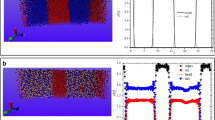Abstract
The distribution and configuration of surfactants at interface in surfactant-water-oil systems have been investigated using discontinuous molecular dynamic simulations. There exists a certain equilibrium concentration of surfactants at interface for the systems with certain interactions among surfactant, water and oil. The interface length and equilibrium morphology of the systems are dependent on the equilibrium concentration of surfactants at interface and the total amount of surfactants. The interaction strengths among surfactant, water and oil determine the equilibrium concentration of surfactants at interface. Three typical configurations of surfactants at interface have been observed: ailene1 surfactant 0 molecules are perpendicular to the interface and arranged closely; ailene2 perpendicular to the interface and arranged at interval 0 of two particles; ailene3 lie down in the interface partly. 0
Similar content being viewed by others

References
Safran S A.Statistical Thermodynamics of Surfaces, Interfaces and Membranes. MA: Addison-Wesley Publishing Company, 1994.
Roan J R, Hu C K. Crossover from the Hydrodynamic Regime to the Thermal Fluctuation Regime in a Two-Dimensional Phase-Separation Binary Fluid Containing Surfactants.Phys Rev E, 2000,62: 766–774.
Laradji M, Mouritsen O G, Toxvaerd S,et al. Molecular Dynamics Simulations of Phase Separation in the Presence of Surfactants.Phys Rev E, 1994,50: 1243–1252.
Franzese G, Malesolo G, Skibinsky A,et al. Generic Mechanism for Generating a Liquid Phase Transition.Nature, 2001,409: 692–695.
Kawakatsu T, Kawasaki K, Furusaka M,et al. Theories and Computer Simulations of Self-Assembling Surfactant Solutions.J Phys: Condens Matter, 1994,6: 6385–6408.
Eillott J R, Hu L. Vapor-Liquid Equilibria of Square-Well Spheres.J Chem Phys, 1999,110: 3043–3048.
Alder B J, Wainwright T E. Studies in Molecular Dynamics. I. General Method.J Chem Phys, 1959,31: 459–466.
Allen M P, Tildesley D J.Computer Simulation of Liquid. New York: Oxford University Press, 1987.
Smit B. Computer Simulations of a Water/oil Interface in the Presence of Micelles.Nature, 1990,348: 624–625.
Larson R G. Monte Carlo Simulation of Microstructural Transitions in Surfactant Systems.J Chem Phys, 1992,96: 7904–7918.
Liu H Y, Zou X W, Yuan Y Q,et al. Effects of Properties of the Surfactant on Its Aggregate Behavior.Eur Phys J E, 2002,8: 373–376.
Yuan Y Q, Zou X W, Liu H Y. Effects of Concentration and Conformation of Surfactants on the Phase Separation of Surfactant-Water-Oil System.Chin Phys Lett, 2004,21: 709–712.
Author information
Authors and Affiliations
Corresponding author
Additional information
Foundation item: Supported by the National Natural Science Foundation of China (10274056) and the Foundation of the Education Ministry of Hubei Province
Biography: YUAN Yin-quan (1964-), male, Ph. D., research direction: soft matter.
Rights and permissions
About this article
Cite this article
Yin-quan, Y., Zhi-bo, S., Yun, X. et al. Effects of interactions among surfactants, water and oil on equilibrium configuration of surfactant-water-oil systems. Wuhan Univ. J. Nat. Sci. 9, 895–898 (2004). https://doi.org/10.1007/BF02850794
Received:
Issue Date:
DOI: https://doi.org/10.1007/BF02850794



